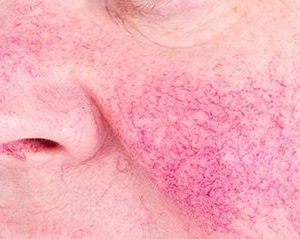- Skip Storing This Everyday Product in the Fridge Door
- Green Tea + B3 Pairing May Boost Brain Health
- Navigating Your Midlife Crisis: Embracing New Possibilities
- City Raccoons Showing Signs of Domestication
- Mapping the Exposome: Science Broadens Focus to Environmental Disease Triggers
- One Week Less on Social Media Linked to Better Mental Health
- Your Brain Changes in Stages as You Age, Study Finds
- Some Suicide Victims Show No Typical Warning Signs, Study Finds
- ByHeart Formula Faces Lawsuits After Babies Sickened With Botulism
- Switch to Vegan Diet Could Cut Your Greenhouse Gas Emissions in Half
Tips To Getting Your Rosacea Under Control

Rosacea is a common skin condition that causes redness on a person’s face.
It commonly appears as a tendency to blush or flush more easily, but also can cause more serious symptoms like:
-
Swollen skin.
-
Skin that stings, burns or is very sensitive.
-
Visible broken blood vessels.
-
Acne-like breakouts.
-
Oily skin.
“With rosacea, there can be many triggers that will worsen symptoms or cause a flare-up,” said Dr. Lycia Thornburg, a board-certified dermatologist in Rapid City, S.D..
Still, “it’s possible to control your rosacea and even prevent it from getting worse by recognizing and avoiding triggers, ranging from alcohol to sunlight to the skin care products you use,” she added in an American Academy of Dermatology (AAD) news release.
To help manage rosacea symptoms, Thornburg and the AAD recommend that people:
Choose rosacea-friendly products. Look for products that say they are noncomedogenic, meaning they don’t clog pores and are made for sensitive skin. Avoid face products that contain alcohol, camphor, fragrance, glycolic acid, lactic acid, menthol, sodium laurel sulfate and urea.
Test skin care products. Before using any products, test them on a quarter-sized patch of your skin on the inside of your arm every day for a week to 10 days. If your skin remains clear, that means the product most likely won’t cause a rosacea flare-up.
Cleanse and moisturize. Avoid the temptation to skip cleansing if your skin feels irritated. Cleansing up to twice a day will help remove oil and dirt that can make irritation worse. Gently apply a mild cleanser in a circular motion with your fingertips, then rinse it all off and gently pat your face dry with a clean towel. Moisturizing after cleaning, even if your skin feels oily, helps hydrate your skin to reduce irritation.
Protect from the sun. Stay in the shade as much as possible, wear sun-protective clothing and apply a broad-spectrum water-resistant sunscreen with SPF 30 or higher to all exposed skin. Look for sunscreens containing zinc oxide, titanium dioxide or both.
Be gentle. Don’t rub or scrub your face, or use washcloths, facial sponges or exfoliators. Those can irritate your skin and make rosacea worse.
Use makeup if desired. Just because you have rosacea doesn’t mean you have to avoid makeup. A yellow-tinted concealer can mask discoloration, and a green-tented concealer can camouflage redness. Just keep in mind that some makeups can irritate skin. Dermatologists often recommend water-based or powder makeup, because it usually doesn’t irritate rosacea.
Thornburg notes that while rosacea is common, there are other skin conditions that cause similar symptoms. A board-certified dermatologist can help diagnose your problem, find a treatment that works best and teach you to avoid triggers.
“If you are unable to address your symptoms by making changes to skin care, a dermatologist will be able to develop a personalized treatment plan,” Thornburg said. “There are many factors to consider when treating rosacea, including the possibility that it might not be rosacea.”
SOURCE: American Academy of Dermatology, news release, April 9, 2024
Source: HealthDay
Copyright © 2025 HealthDay. All rights reserved.










